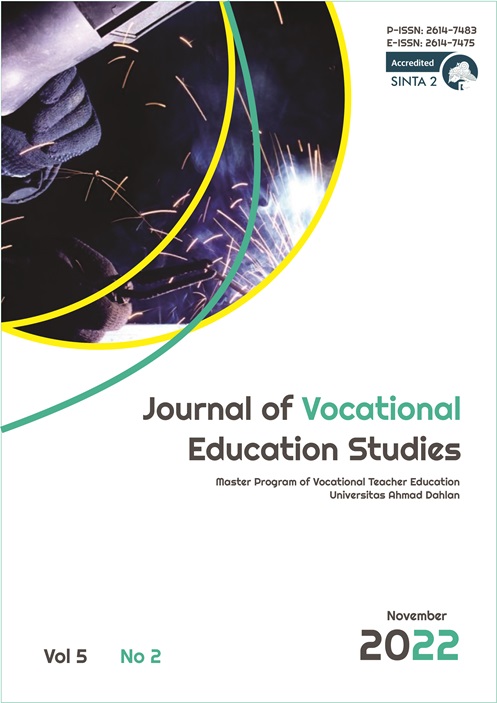Creating Interactive Online Learning Experiences among Secondary School Students in Lagos State, Nigeria.
DOI:
https://doi.org/10.12928/joves.v5i2.6528Keywords:
Creating, Interactive, Online Learning, Experiences, Teaching and feedback.Abstract
In the recent time teaching and learning is no more confined to face-to-face exercise where the students are mere listeners instead of fully participate in the class activities. The study is on creating interactive online learning experiences among Secondary School students in Lagos State, Nigeria. It was a survey study and the population for the study included all the teaching staff members of all the Public Senior Secondary School in Shomolu Local Government Area. Random sampling technique was used to select 100 teachers who responded to the developed questionnaire. A structured questionnaire containing 40 questionnaire items were developed on four point scales. The response scale for the questionnaire is Strongly Agree (4), Agree (3), Disagree (2) and Strongly Disagree (1). The questionnaire was face validated while the reliability of the test was determined using test re-test procedure. The findings of the indicated that there are number ways which online learning can be made interactive. These ways include: involving feedback, creating interactive activities, Assignments & Breakout groups, exploring other free ICT tools, limiting seat time, good teachers/student relationship, discourage absenteeism, allow few minutes of jokes among students during classroom activities and creating course content that is engaging and encouraging peer. Teachers and students related challenges to effective and interactive online learning include lack of motivation in online learners, technical difficulties with online teaching tools, time-consuming resources, setting and forgetting online learning activities, poor learning outcomes, lack of appropriate devices, poor learning space at home, stress among students, lack of fieldwork and access to laboratories and loneliness. It was recommended that creating interactive online learning experiences among secondary school students in Lagos State, could be through involving feedback, creating interactive activities, assignments and breakout groups, exploring other free ICT tools, limiting seat time and good teachers/student relationship.
References
Amy Peterson (2016). Five ways to make your online classrooms More Interactive. Retrieved from https://www.facultyfocus.com/author/amypeterson/
Coverdale-Jones, T. (2000). The use of video-conferencing as a communication tool for language learning: Issues and considerations. Journal of Language Learning Technologies, 32(1), 27-40
Elsa R., Nasrullah & Eka P. E. (2020). Teacher’s challenges towards online learning in pandemic era. Journal of Linguistics, Literature and Language Teaching 10(2). Retrieved from http://jurnal.uin-antasari.ac.id/index.php
Glenn M. K (2020). We can make online learning a positive force in education. EduSource. Retrieved from https://edsource.org
Hampel, R., & Stickler, U. (2005). New skills for new classrooms: Training tutors to teach languages online. Computer Assisted Language Learning, 18(4), 311-326.
Karen G. (2021). How to Make Online Learning More Engaging and Interactive. Retrieved from https://karengrosseducation.com/
Mary Beth Carl (2020). How interactive learning will shape the classrooms of the future. Retrieved from https://www.acetechgroup.com
Rasheed, R. A., Kamsin, A., & Abdullah, N. A. (2020). Challenges in the online component of blended learning: A systematic review.
Computers and Education, 144(March 2019), 103701. Retrieved from https://doi.org/10.1016/j.compedu.2019.103701
Turning Technologies (2020). What is interactive learning? Retrieved from https://www.turningtechnologies.com
Will (2021). 5 ways to make online learning more interactive. Retrieved from https://www.ef.com/wwen/blog/general/5-ways-make-online-learning-interactive/#
Downloads
Published
Issue
Section
License
Copyright (c) 2022 Universitas Ahmad Dahlan

This work is licensed under a Creative Commons Attribution-ShareAlike 4.0 International License.
Authors who publish with Journal of Vocational Education Studies (JOVES) agree to the following terms: Authors retain the copyright and grant the Universitas Ahmad Dahlan right of first publication with the work simultaneously licensed under a Creative Commons Attribution License (CC BY-SA 4.0) that allows others to share (copy and redistribute the material in any medium or format) and adapt (remix, transform, and build upon the material) the work for any purpose, even commercially with an acknowledgement of the work's authorship and initial publication in Universitas Ahmad Dahlan. Authors are able to enter into separate, additional contractual arrangements for the non-exclusive distribution of the journal's published version of the work (e.g., post it to an institutional repository or publish it in a book), with an acknowledgement of its initial publication in Universitas Ahmad Dahlan. Authors are permitted and encouraged to post their work online (e.g., in institutional repositories or on their website) prior to and during the submission process, as it can lead to productive exchanges, as well as earlier and greater citation of published work (See The Effect of Open Access).










.png)



